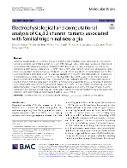Electrophysiological and computational analysis of Ca(v)3.2 channel variants associated with familial trigeminal neuralgia

Author
Gambeta, Eder
Publication date
2022Published in
Molecular BrainVolume / Issue
15 (November)ISBN / ISSN
ISSN: 1756-6606ISBN / ISSN
eISSN: 1756-6606Metadata
Show full item recordCollections
This publication has a published version with DOI 10.1186/s13041-022-00978-9
Abstract
Trigeminal neuralgia (TN) is a rare form of chronic neuropathic pain characterized by spontaneous or elicited paroxysms of electric shock-like or stabbing pain in a region of the face. While most cases occur in a sporadic manner and are accompanied by intracranial vascular compression of the trigeminal nerve root, alteration of ion channels has emerged as a potential exacerbating factor. Recently, whole exome sequencing analysis of familial TN patients identified 19 rare variants in the gene CACNA1H encoding for Ca(v)3.2T-type calcium channels. An initial analysis of 4 of these variants pointed to a pathogenic role. In this study, we assessed the electrophysiological properties of 13 additional TN-associated Ca(v)3.2 variants expressed in tsA-201 cells. Our data indicate that 6 out of the 13 variants analyzed display alteration of their gating properties as evidenced by a hyperpolarizing shift of their voltage dependence of activation and/or inactivation resulting in an enhanced window current supported by Ca(v)3.2 channels. An additional variant enhanced the recovery from inactivation. Simulation of neuronal electrical membrane potential using a computational model of reticular thalamic neuron suggests that TN-associated Ca(v)3.2 variants could enhance neuronal excitability. Altogether, the present study adds to the notion that ion channel polymorphisms could contribute to the etiology of some cases of TN and further support a role for Ca(v)3.2 channels.
Keywords
Trigeminal neuralgia, Ion channel, Calcium channel, CACNA1H, Ca(v)3, 2 channel, Channelopathy
Permanent link
https://hdl.handle.net/20.500.14178/1682License
Full text of this result is licensed under: Creative Commons Uveďte původ 4.0 International







